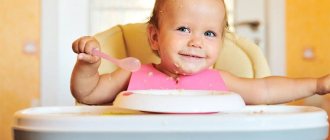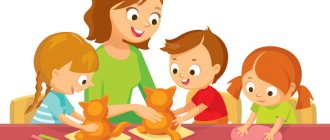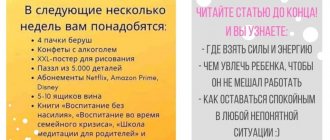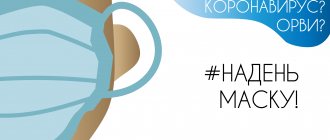Information during a pandemic is a necessary event, so coronavirus reminders for children and parents from Rospotrebnadzor are relevant in our time during the spread of the new coronavirus infection COVID-19, which has become the main topic and problem in 2020. Absolutely all preschool educational institutions, schools and other educational institutions are faced with the need to truthfully and timely inform the population and develop recommendations and leaflets.
We recommend:
- Memo to parents on coronavirus prevention
- Coronavirus reminders for workers in pictures
Informing and distributing leaflets on the prevention of coronavirus among parents of children in preschool educational institutions or schools and recommendations of Rospotrebnadzor on personal hygiene and sanitary standards today is one of the methods of combating the virus. By following the recommendations of the Chief Sanitary Doctor of the Russian Federation and the instructions of Rospotrebnadzor, we become information savvy and thereby reduce the risks of infecting others and spreading coronavirus infection (Covid-19).
Ready-made Coronavirus Reminders for children and parents in the form of pictures (width 1500 pixels) are suitable for schools, kindergartens or other educational organizations, as they are colorfully designed in the form of a sequence of actions and basically contain rules for the prevention of a new coronavirus infection. The pictures can simply be printed on sheet H4 or H3 and used as illustrative material or placed on stands at a school or preschool educational institution.
Coronavirus prevention reminder for children
To explain the rules for preventing coronavirus infection in schools and preschool educational institutions, a memo on the prevention of coronavirus infection for children is used, in which schoolchildren and preschoolers are explained in pictures what coronavirus is, how it is transmitted from person to person, what the symptoms of coronavirus infection may be and what the child needs to do. to protect yourself from becoming infected with this dangerous new virus.
Center for Hygiene and Epidemiology in the Moscow Region
Among the activities aimed at strengthening the health and improving the physical development of the child, compliance with hygienic requirements for clothing and footwear is important.
Clothing serves to protect a person from the adverse effects of the external environment, protects the surface of the skin from mechanical damage and contamination. With the help of clothing, an artificial under-clothing microclimate is created around the body, significantly different from the climate of the external environment. Due to this, clothing significantly reduces heat loss from the body, helps maintain a constant body temperature, facilitates the thermoregulatory function of the skin, and ensures gas exchange processes through the skin.
Shoes are designed to protect feet from adverse environmental conditions: cold, pollution, various damages. The main requirement for it is full compliance with the size and shape of the foot. Shoes for a child should be soft, light, have elastic soles and low heels.
The main requirement for children's clothing is its rationality. It should, first of all, provide the child with a feeling of comfort and a favorable microclimate. Aesthetic requirements for children's clothing, although high, remain in second place. When choosing clothes for children, parents should pay attention not only to their appearance. The first place should be given to thermal properties, ease of fit, and lightness. Clothing should not restrict the child's movements, disrupt the physiological functions of the skin and remove metabolic products from its surface. The fabrics from which children's clothing is made must be breathable, hygroscopic (able to easily absorb water and water vapor), and not lose these positive qualities and attractive appearance after repeated washing and ironing.
Any shoes should be spacious enough in the toe area, otherwise the foot will become deformed. Its heel holds the heel tightly so that it does not slide towards the toe. If the shoes are chosen correctly, this allows the child to move his toes freely. Children's legs grow quickly. The shoes from which they grew, squeezing the foot, disrupts blood circulation in it, which negatively affects normal functioning and development. In this regard, it is necessary to constantly monitor whether boots or shoes are squeezing the child’s foot. Large shoes bought for growth are just as harmful as tight ones. In addition, it often causes abrasions.
Currently, there is a trend towards students using school clothes. The interaction between the child’s skin and the fabrics of school clothes is determined by the hygienic properties of the fabric: thickness, weight, air and vapor permeability, hygroscopicity, moisture capacity, hydro- and lipophilicity, hydrophobicity, as well as thermal conductivity. Consequently, the hygienic properties of school uniforms are very important for the thermal comfort and well-being of the child. The requirements for the composition of the fabric from which it is made are more stringent, because the child wears these school clothes for a significant part of the day (a schoolchild spends 5-6 hours in a school uniform, taking into account the extended day up to 8-9 hours). It is necessary to pay attention to the cut of clothes, because... Improperly tailored clothing can cause harm.
Parents sometimes look only at the price of clothes, and not at the composition of the fabric, and buy something that their children should not wear. An ordinary children's suit can be made from fabric consisting of 67% chemical fibers. You can wear such a costume for a holiday, but under no circumstances should you wear it to school. It is important for parents to know that a modern school uniform must meet all hygienic requirements, but at the same time be stylish, varied, and fashionable. An ergonomically perfect (statically and dynamically comfortable for a child) school uniform allows you to shape the posture of a child’s figure and is designed to provide dynamic comfort.
Recently, sports shoes have become widespread. Some of its types (sneakers, sneakers) are used not only for sports, but also for everyday wear on the street and at home. This is wrong and harmful. Each type of sports shoes must correspond to its purpose and be used not permanently, but temporarily, strictly for its intended purpose. All types of children's shoes must be well secured.
Cotton tights, knee socks, and socks for children are highly hygroscopic. Such products made from synthetic fibers are completely unable to absorb moisture, as a result of which the feet sweat in them, overheat in the summer, and, on the contrary, become colder in the winter.
When choosing clothes (school uniforms) and shoes:
- Carefully study the clothing labeling (label with manufacturer's data, fabric composition and recommendations for cleaning and washing the product).
- Pay attention to the symbols indicating how to care for the product.
- The fabric from which the uniform is sewn must be at least half wool, cotton or viscose, that is, natural materials. We recommend uniforms made of cotton and linen for autumn and spring, and wool and cashmere for winter.
- The color of children's clothing (school uniform) should be calm and muted. Bright colors increase fatigue in children and can provoke hidden irritation.
- It is better to avoid color combinations such as black and white; such a sharp contrast greatly tires your eyesight and can even cause headaches.
- It is better to choose several items of school clothing for your child at once, so that they can be easily changed during the week.
- Determine the required shoe size for your child by measuring the length of the child's sole with a centimeter. Correctly selected shoes are considered shoes when the distance from the end of the big toe to the inner surface of the boots or shoes should be 0.5 - 1 cm.
- When choosing shoes for a child, you need to try them on both feet. In this case, the child should not sit, but stand, then the load from the entire body weight will fall on the foot.
- When choosing shoes for winter, you should give preference to shoes made of felt or cloth; you can use insulated shoes or boots.
- It is advisable to wear felt boots only in very cold weather and under no circumstances stay in them indoors, since their shape does not meet many of the requirements for children's shoes. The same applies to rubber boots. They can only be used in rainy weather or for walking on wet grass. You need to put a cloth insole inside the rubber boots and put them on over a wool sock that absorbs moisture well.
- As summer shoes for children, it is advisable to purchase shoes, sandals, sandals made from leather or textile materials. To prevent the child's feet from overheating, the top of summer shoes should be openwork, this will ensure air circulation and protect the foot from overheating.
- When purchasing children's clothing (school uniforms) and shoes, you need to pay attention to the availability of documents confirming quality and safety. Currently, for children's clothing and footwear, both domestic and imported, this document is a certificate of conformity; for first layer clothing (underwear) – certificate of state registration.
For example, if it indicates dry cleaning, it is better to refuse such clothes for a child; chemicals can be harmful to the health of your schoolchild, who will spend almost the whole day in this suit.
How to wear a mask correctly during coronavirus
Before using masks, children and their parents should study the memo on wearing masks during coronavirus, which will allow you to learn how to properly wear medical masks or reusable masks, which side to wear masks in crowded places, including schools and preschool educational institutions. Children and parents need to remember that a disposable mask is worn for 2-3 hours and disposed of, a reusable mask is worn for 3-4 hours, after which it is washed with soap and ironed. Wear a medical mask with the white side facing your face if you are not sick.
Memo for parents and children on distance learning
In order to properly organize a schoolchild’s workplace at home, Rospotrebnadzor has developed a memo for parents and children on organizing distance learning during the spread of coronavirus, which explains what the lighting and position of the computer monitor should be, that it is necessary to maintain a distance from books and sit correctly, as well as periodically conduct physical exercises minutes.
Consultation for parents: “How to educate cultural and hygienic skills of a preschooler”
Usually, a restless and active child of preschool age can hardly sit in one place while his mother combs his hair or cuts his nails, does not like to wash his hair, and brushes his teeth hastily, and only after repeated reminders from adults. And how difficult it is for a child to wake up early in the morning and get dressed independently when getting ready for kindergarten. We must remember what to wear, what to wear, how to fasten buttons, tie shoelaces, etc.
The child does not want to make efforts and transfers self-care activities to mom or dad. And parents themselves, when the child has even the slightest difficulty, rush to help. Of course, it is much easier and faster for a mother to wash and dress the child herself than to wait for the child to do this slowly and clumsily. And at the same time, it should be understood that in this way it forms a passive position in the child and inhibits the development of his independence and cultural and hygienic skills. Therefore, the child comes to kindergarten and cannot cope, helplessly asks the teachers: “help”, “button up”, “put on clothes”.
Therefore, instead of doing absolutely everything for the child, take care to provide conditions at home that are favorable for the development of cultural and hygienic skills in the child . Constantly repeat certain actions with your child until the skills are fully formed.
What should a child be able to do at different age stages of preschool?
First of all, let’s find out the sequence of formation in a preschool child of cultural and hygienic skills and skills that are advisable to focus on.
So, already in the second year of life, children should be able to put their hands under running water in the washbasin, wash off soap suds from their hands, dry themselves with a towel, drink from a cup, eat with a spoon, use a napkin, handkerchief, and the like.
Three-year-old children should already eat independently and carefully, chew food thoroughly, hold a spoon correctly, roll up their sleeves before washing, use soap, wash, and wipe their face with a towel. Children of primary preschool age should be taught to use cutlery (spoon, fork, knife), napkin, eat carefully, rinse their mouth after eating, brush their teeth properly, comb their hair, and follow the rules for using personal hygiene items. Children of senior preschool age are already able to independently control personal hygiene, behave culturally at the table, and the like.
How to encourage your child to be independent in caring for themselves?
The child is greatly encouraged to be active and take independent action in caring for himself by the favorable organization of conditions for carrying out hygiene procedures. Therefore, in order to provide your child with convenience and comfort, create all the necessary conditions for this in the bathroom, in particular:
— attach the towel hook at the child’s height level;
— place a low chair next to the washbasin, on which it will be convenient for the child to reach the tap with his hands;
- attach the handle-holder to the wall above the bathtub so that the child can hold on to it with both hands while washing himself, washing his feet, or taking a hygienic shower;
- Place a mat next to the bathtub to prevent your child from slipping.
Be sure to buy your child his personal hygiene items: towels, a comb for combing his hair, a toothbrush, baby soap, a washcloth, and the like. Give your child the opportunity to choose them themselves in the store. Children usually like accessories that are brightly colored, have interesting patterns, or have images of their favorite characters or cartoons.
All personal hygiene items for a child should be selected taking into account his age capabilities and anthropometric characteristics. For example, the size of a bar of soap must correspond to the size of a child’s hand, the towel must have a loop so that the child can pick it up and hang it with one movement, cups for a toothbrush must be stable, comfortable and safe; The comb should be selected with blunt teeth so as not to damage the baby’s delicate skin.
What do parents need to remember when teaching their child to be neat?
When working on developing clear cultural and hygienic skills in your child, remember a few important rules:
- the haste and impatience of adults muffles the child’s initiative, his desire to be independent;
— in the process of communicating with your child, express a positive attitude towards cleanliness and tidiness as often as possible;
- organize routine moments in an interesting way - then the child will willingly perform certain actions. During hygiene procedures, say, tell your child short didactic poems, take your child’s favorite toy with you to the bathroom, “who also wants to be neat”;
- encourage any childish manifestations of independence, even the most clumsy ones;
- Do not criticize the child under any circumstances, only praise;
- do not leave the child unattended, even if he learns to independently perform one or another hygiene procedure.
Don't expect your child to learn everything at once.
At the age of three, he will wash his face only on the condition that an adult stands “over his soul.”
At four years old, he will do the same if you remind him that every person needs to wash his face and brush his teeth. In addition, the child will certainly expect you to praise him for performing the action correctly. The desire to earn praise is exactly the incentive that encourages a preschool child to take care of himself independently. And only then, when you develop in the child the awareness that behind every action there is a rule, when he has learned a certain norm, then he will go to the bathroom on his own, because he will feel the need to be neat, to keep his body clean.
Therefore, to develop any stable cultural and hygienic skills in a child, you will need not only a long time and your patience, but also support in the child’s positive emotions from independently performing certain hygiene procedures. And, of course, parents - be a good example for your child!
In preschool age, human formation occurs, both psychological and physiological. For children of this age, consistency and consistency are very important. Therefore, in order for a child to grow up healthy, it is very important to observe a daily routine and some hygiene standards, which parents should teach their children to do from childhood. The basic rules of personal hygiene are as follows.
1. Hand washing. The child needs to be explained that he takes various objects with his hands: pencils, pens, books, toys, strokes animals (cats, dogs), takes hold of door handles, touches various objects (handles, chains, hooks, etc.) in the toilet rooms. All these objects have dirt on them, often invisible to the eye and it remains on the skin of the fingers. If you take food (bread, apples, candy, etc.) with unwashed hands, then this dirt gets first into your mouth and then into your body. Dirt transmits various diseases from a sick person to a healthy one. Therefore, you need to wash your hands before eating, after visiting the toilet, after any contamination (playing outside, playing with animals, etc.) and before going to bed.
2. Clean body skin. The skin protects the human body from disease. When a child runs and jumps, beads of sweat appear on his skin. In addition, the skin has a thin layer of sebum. If the skin is not washed for a long time, then oil and sweat accumulate on it, on which dust particles are retained. This makes the skin dirty and no longer protects the body. Therefore, the skin needs to be washed! Every morning all children must wash themselves: wash their face, hands, neck, ears. You also need to wash your face after walking and in the evening. First, you need to wash your hands well with soap and water from the tap. Hands should be soaped once or twice on both sides and between the fingers, rinse off the soap suds well, and check the cleanliness of the nails. Then, with clean hands, wash your face, neck, and ears. After washing, pat dry with a clean, dry towel. Each child should have their own towel. If the towel remains clean after drying with it, it means the child washed himself well.
Before going to bed, it is necessary to wash your feet because the skin on your feet sweats especially heavily and dirt accumulates. Rare washing of feet, wearing dirty socks and stockings contributes to the appearance of diaper rash and abrasions, and also predisposes to fungal diseases.
After washing your feet, dry them thoroughly with a special towel. Change stockings and socks at least every other day. At home, change into house shoes or slippers. Water procedures in the morning and evening before bed are not only hygienic, but also hardening, have a good effect on the nervous system, and help you fall asleep quickly.
The entire body must be washed at least once a week at home in the bath, shower or sauna. In order to remove fat and dirt from the skin, you must wash with warm water and rub your body with a washcloth and soap. After washing, you should put on clean underwear.
3. Washing your hair. You need to wash your hair very carefully, because... A lot of sebum, dirt and dust accumulate on them and between them. It is easier to care for short hair: it washes better. Therefore, it is advisable for boys to cut their hair short, especially in the summer. Girls with long hair need to wash their hair at least once a week, and after washing, comb it thoroughly only with your own comb.
4. Nails. Fingernails and toenails also require care. They need to be carefully trimmed once every 2 weeks because dirt usually accumulates under long nails, which is difficult to remove. In addition, such nails can scratch the skin of yourself and others. Dirty nails are a sign of a sloppy, sloppy person who does not follow the rules of personal hygiene. Under no circumstances should you bite your nails!
5. Healthy teeth. It is important to start caring for your child’s oral cavity and teeth in a timely manner. Parents should remember that caring for baby teeth and keeping them healthy until permanent teeth appear is just as important as caring for permanent teeth, because caries of primary teeth causes destruction of permanent teeth.
Brushing your teeth is done like this: first you need to wash your hands with soap and rinse your toothbrush well under running water; thoroughly rinse your mouth with water at room temperature, then take a little children’s toothpaste or powder onto a toothbrush moistened with water and brush the front and side surfaces of the teeth with your teeth closed, while the brush should move from bottom to top and back. After this, the child should open his mouth and brush the chewing and inner surfaces of the teeth. Finish brushing your teeth by thoroughly rinsing with water several times until there are no particles of powder or paste left. Next, rinse the toothbrush thoroughly, shake off and place in a glass with the handle down so that the brush dries well.
To form a correct bite, do not try to feed pureed food to children with baby teeth. Let them gnaw on apples, carrots and bread crusts. Vigorous chewing increases not only the secretion of saliva, but also the flow of blood to the jaws, improving their nutrition. In this case, the jaws develop normally, and the permanent teeth are arranged in even rows.
Hygienist
State Institution "Dzerzhinsky RCGE" M.M. Kuranets







